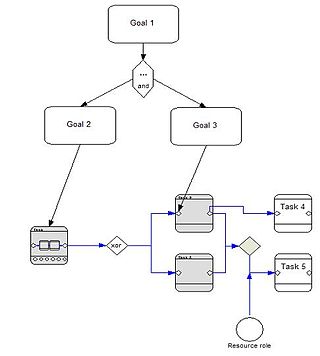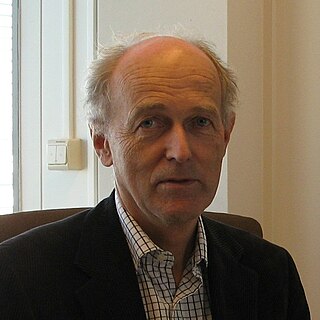Related Research Articles
A modeling language is any artificial language that can be used to express information or knowledge or systems in a structure that is defined by a consistent set of rules. The rules are used for interpretation of the meaning of components in the structure.
Terence Aidan (Terry) Halpin is an Australian computer scientist who is known for his formalization of the Object Role Modeling notation.

The Zachman Framework is an enterprise ontology and is a fundamental structure for enterprise architecture which provides a formal and structured way of viewing and defining an enterprise. The ontology is a two dimensional classification schema that reflects the intersection between two historical classifications. The first are primitive interrogatives: What, How, When, Who, Where, and Why. The second is derived from the philosophical concept of reification, the transformation of an abstract idea into an instantiation. The Zachman Framework reification transformations are: identification, definition, representation, specification, configuration and instantiation.
Data quality refers to the state of qualitative or quantitative pieces of information. There are many definitions of data quality, but data is generally considered high quality if it is "fit for [its] intended uses in operations, decision making and planning". Moreover, data is deemed of high quality if it correctly represents the real-world construct to which it refers. Furthermore, apart from these definitions, as the number of data sources increases, the question of internal data consistency becomes significant, regardless of fitness for use for any particular external purpose. People's views on data quality can often be in disagreement, even when discussing the same set of data used for the same purpose. When this is the case, data governance is used to form agreed upon definitions and standards for data quality. In such cases, data cleansing, including standardization, may be required in order to ensure data quality.

The term process model is used in various contexts. For example, in business process modeling the enterprise process model is often referred to as the business process model.

Enterprise integration is a technical field of enterprise architecture, which is focused on the study of topics such as system interconnection, electronic data interchange, product data exchange and distributed computing environments.

Extended Enterprise Modeling Language (EEML) in software engineering is a modelling language used for Enterprise modelling across a number of layers.
The SEQUAL framework is systems modelling reference model for evaluating the quality of models. The SEQUAL framework, which stands for "semiotic quality framework" is developed by John Krogstie and others since the 1990s.

Enterprise modelling is the abstract representation, description and definition of the structure, processes, information and resources of an identifiable business, government body, or other large organization.

The TOVE project is a project to develop an ontological framework for enterprise integration (EI) based on and suited for enterprise modeling. In the beginning of the 1990s it was initiated by Mark S. Fox and others at the University of Toronto.

Jean Leonardus Gerardus (Jan) Dietz is a Dutch Information systems researcher, Emeritus Professor of Information Systems Design, and part-time Professor of Enterprise Engineering at the Delft University of Technology, known for the development of the Design & Engineering Methodology for Organizations. and his work on enterprise ontology.
Colette Rolland is a French computer scientist and Professor of Computer Science in the department of Mathematics and Informatics at the University of Paris 1 Pantheon-Sorbonne, and a leading researcher in the area of information and knowledge systems, known for her work on meta-modeling, particularly goal modelling and situational method engineering.
Ronald K. (Ron) Stamper is a British computer scientist, formerly a researcher in the LSE and emeritus professor at the University of Twente, known for his pioneering work in Organisational semiotics, and the creation of the MEASUR methodology and the SEDITA framework.
Jacobus Nicolaas (Sjaak) Brinkkemper is a Dutch computer scientist, and Full Professor of organisation and information at the Department of Information and Computing Sciences of Utrecht University.

Systems modeling or system modeling is the interdisciplinary study of the use of models to conceptualize and construct systems in business and IT development.

Arne Sølvberg is a Norwegian computer scientist, professor in computer science at the Norwegian University of Science and Technology (NTNU) in Trondheim, Norway, and an expert in the field of information modelling.
Janis Askolds Bubenko junior was a Swedish computer scientist and Professor Emeritus at the Department of Computer and Systems Science, Royal Institute of Technology and Stockholm University.
Henderik Alex (Erik) Proper is a Dutch computer scientist, an FNR PEARL Laureate, and a senior research manager within the Computer Science (ITIS) department of the Luxembourg Institute of Science and Technology (LIST). He is also adjunct professor in data and knowledge engineering at the University of Luxembourg. He is known for work on conceptual modeling, enterprise architecture and enterprise engineering.

Eckhard D. Falkenberg is a German scientist and Professor Emeritus of Information Systems at the Radboud University Nijmegen. He is known for his contributions in the fields of information modelling, especially object-role modeling, and the conceptual foundations of information systems.
Andreas Lothe Opdahl is a Norwegian computer scientist and Professor of Information Systems Development at the University of Bergen, known for his theory about Security requirements engineering. and for with Guttorm Sindre coining the term Misuse case.
References
- ↑ John Krogstie, About The Author/Editor. Accessed 02 Feb 2009.
- ↑ CURRICULUM VITAE 24/7/2008. Accessed 02 Feb 2009.
- ↑ John Krogstie et al. (2006). "Process models representing knowledge for action: a revised quality framework". In: European Journal of Information Systems (2006) 15, pp.91–102.
- ↑ Jan Mendlin et al. (2006) "On the Correlation between Process Model Metrics and Errors" Conference paper.
- ↑ D.L. Moody, et al. (2002). "Evaluating the quality of process models: Empirical testing of a quality framework". In: Stefano Spaccapietra et al. (ed.) Conceptual Modeling - ER 2002, Proceedings, LNCS 2503, pp. 380-396.
- ↑ O.I. Lindland, G. Sindre and Arne Sølvberg (1994) "Understanding quality in conceptual modeling". In: IEEE Software 11(2), 42–49.
- ↑ KROGSTIE J, LINDLAND OI and SINDRE G (1995) "Defining quality aspects for conceptual models". In: Proceedings of the IFIP8.1 Working Conference on Information Systems Concepts (ISCO3): Towards a Consolidation of Views, 28–30 March, Marburg, Germany (FALKENBERG E, HESS W and OLIVE E, Eds), Chapman & Hall: London, UK.
- ↑ KROGSTIE J and JøRGENSEN HD (2002) "Quality of interactive models". In: First International Workshop on Conceptual Modelling Quality (IWCMQ’02), 11 October 2002. (OLIVE A, YOSHIKAWA M and YU E, Eds), Springer Verlag: Berlin, Germany.
- ↑ STAMPER R (1996) "Signs, norms, and information systems". In: Signs at Work. B. Holmqvist et al. (Eds). Walter de Gruyter: Berlin, Germany. pp 349–397.
- ↑ Krogstie, John, "Perspectives to Process Modeling," in: Business Process Management : Theory and Applications. Berlin/Heidelberg, DE: Springer, 2013.
- ↑ John Krogstie, List of publications from the DBLP Bibliography Server. Accessed 02 Feb 2009.
- ↑ See also John Krogstie scholar.google.no